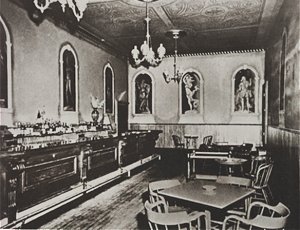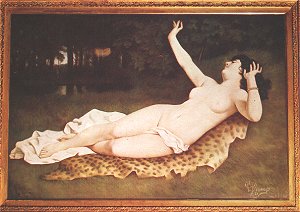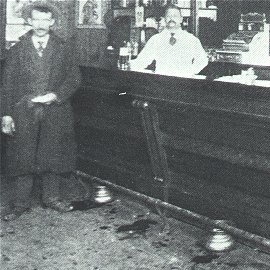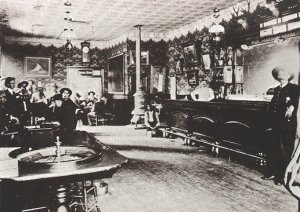The famous Teller House Bar in Central City, Colorado, with classic saloon art. |
SALOONSAll but gone in the 21st century, the saloon or similar drinking establishments more than just dotted the landscape at the beginning of the 20th century; they were, in fact, an economic force in the country when times were tough exiting the 1890s. As per tradition and accepted morals of the time, the saloon was a gathering place for men, and the few ladies in attendance were entertainment of some sort for the men. Much of this attitude was forcibly altered between 1900 and 1920 when the saloons of America were compelled to close or convert to some other business. In 1900, though, it was a place where a man could go to be alone, commune with his buddies, discuss business, gamble his savings away, take a break from responsibility, drown his sorrows, and listen to ragtime. Since ragtime music was quickly growing in popularity, and there were so many itinerant pianists roaming through the country, it was common for a saloon-keeper to keep one or more ragtime pianists employed to provide some background aura and have them work mostly for tips with the knowledge that a replacement was knocking at the door if needed. The pianist also provided a diversion for gamblers or drug dealers trying to get the better of their victims, an accompanist to the occasional female singer, and even appropriate music during fights that might break out in an effort to keep them entertaining as well.
A Bar Nude from the Grand Imperial Hotel in Silverton, Colorado. |
A typical saloon layout included a long bar across one side of the narrow room (anywhere from 10 to 30 feet wide and much deeper) towards the front, and tables against the opposite wall and in the back. There was often a back room where illicit activities could be confined. The pianist was usually against a wall opposite the bar or centrally located in the back portion of the room. A large mirrored shelf unit behind the bar not only stored and displayed the available intoxicants but helped create an illusion of increased space in the room, and could be used for either cheating at cards or catching cheaters. Somewhere near the bar was typically the ubiquitous bar nude, a painting of a Rubenesque beauty in a seductive pose. Affixed to the front of the bar around six to eight inches off the floor was a brass rail intended as foot rest whether standing (many saloons did not have stools) or seated. In numerous locations around most saloons were often-decorative brass or metal urns known as
spittoons, which were the often-mistargeted receptacles for tobacco juice, something that could prove to be both slippery and rank on the wooden floor. Some saloons had a balcony area as a matter of more efficient seating, or to provide a segregated area for preferred customers. Of course, if the saloon was host to the occasional notorious character there would also be one or more bullet holes in the bar (such bars still exist in the U.S.).
Not-so-good aim is evident around these spittoons. |
Going back to the 1850s, there was an established format for most saloons on a regional basis. Much of this depended on the desired or available clientele. It was hard to find any form of food in most of them, and even water was scarce in some areas. However there was always some form of whiskey or similar "hooch" or "moonshine" available, and even cheap grain alcohol in many cases. They were common throughout the western United States since it was a simple matter to quickly raise a building or even a tent and throw together a few tables at which alcohol could be served. The saloon was often the first business established, other than a bank or assay office, in mining towns that sprang up from Colorado to California. Even as the towns faded, one or two of them would remain in business, since depression often led to drinking. By 1900, after the majority of gold and silver rushes were over, the primary unspoken enterprises in many western saloons was either gambling or prostitution. An inebriated person makes for easy pickings. The shifts to such illicit saloon-centered activities happened much earlier in the eastern U.S., but they also served as a base for duping the constant influx of immigrants from Europe with such enticements as land fraud and fake business opportunities.
Gambling in progress in this Midwest saloon. Note the Sheriff standing at right. |
During the 1910s there were a number of socioeconomic and cultural shifts that led to the demise of the neighborhood saloon, one of them being a fatal blow. Women's suffrage had come to a head, and many saloon keepers started changing the nature of their entertainment formats and decor to accommodate a new set of paying customers who would ultimately gain voting rights. Competition from vaudeville and phonograph records also required them to raise the quality of entertainment in an effort to lure customers away from theaters and gramophones. The ultimate demise of the saloon came when it was decided, as
Max Morath so succinctly put it, that "the majority of Americans drank too much, so the majority of Americans voted in prohibition" in a Constitutional amendment that became law in 1920. Many of the songs of 1919 to 1921 dealt with this thorny issue, and it should be known that even though alcohol was legally prohibited, it was being consumed in increasing quantities throughout the prohibition era. But the old neighborhood drinking establishment was usually converted to a drugstore or hardware store, or simply left to rot, and another American tradition died a quick but necessary death. There are still some authentic and recreated saloons in the United States that are worth a visit, although few of them capture the true essence of those dank smoke-filled social centers of yesteryear.








 Loading Page. Please Wait...
Loading Page. Please Wait... 







